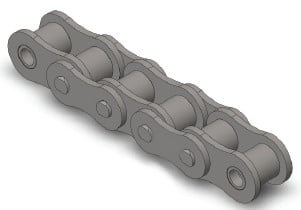Roller chains are one particular in the most efficient and cost eff ective approaches to transmit mechanical electrical power concerning shafts. They operate more than a wide selection of speeds, take care of substantial operating loads, have extremely compact energy losses and are normally low-cost in contrast with other methods
of transmitting power. Successful selection includes following various rather basic techniques involving algebraic calculation plus the use of horsepower and service factor tables.
For any offered set of drive ailments, there are a variety of achievable chain/sprocket confi gurations which can successfully operate. The designer as a result need to be aware of numerous fundamental assortment principles that when utilized effectively, assist balance all round drive performance and expense. By following the steps outlined within this part designers needs to be ready to make selections that meet the needs of the drive and therefore are cost eff ective.
Common Roller Chain Drive Rules
? The advised variety of teeth for the little sprocket is 15. The minimum is 9 teeth – smoother operation is obtained with a lot more teeth.
? The advisable maximum number of teeth to the massive sprocket is 120.  Note that whilst a lot more teeth lets for smoother operation owning also numerous teeth leads to chain jumping off the sprocket following a fairly little volume of chain elongation due to wear – That is certainly chains with a very huge number of teeth accommodate less wear just before the chain will no longer wrap around them adequately.
Note that whilst a lot more teeth lets for smoother operation owning also numerous teeth leads to chain jumping off the sprocket following a fairly little volume of chain elongation due to wear – That is certainly chains with a very huge number of teeth accommodate less wear just before the chain will no longer wrap around them adequately.
? Speed ratios must be 7:1 or much less (optimum) and not greater
than 10:one. For bigger ratios the use of multiple chain reductions is suggested.
? The advisable minimal wrap of your tiny sprocket is 120°.
? The proposed center distance among shafts is 30-50 pitches of chain. There are actually two exceptions to this as follows:
1. The center distance have to be greater than the sum of the outside diameters in the driver and driven sprockets to avoid interference.
two. For velocity ratios better than three:one the center distance should not be much less compared to the outdoors diameter of your huge sprocket minus the outside diameter on the compact sprocket to assure a minimal 120° wrap all over the small sprocket.